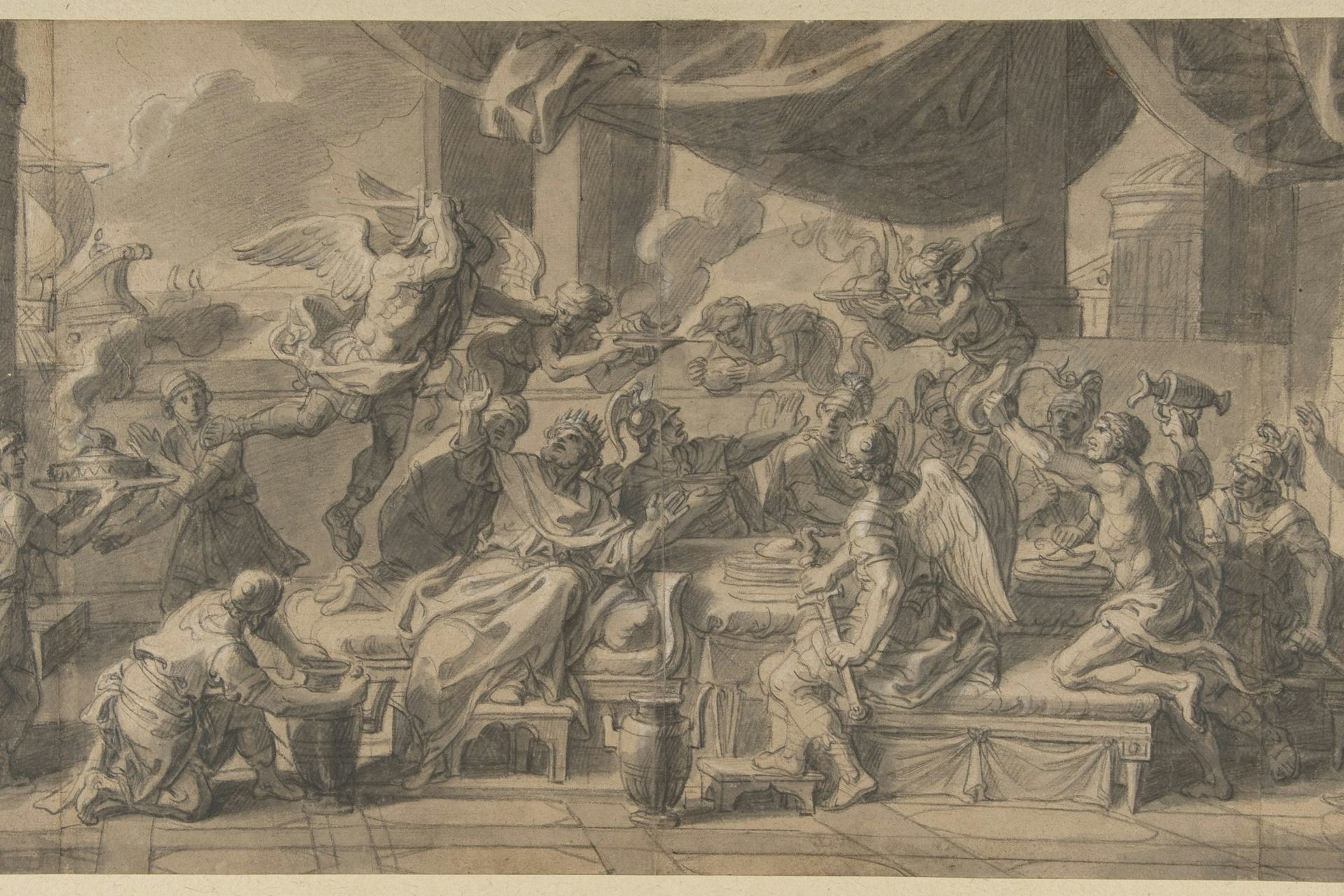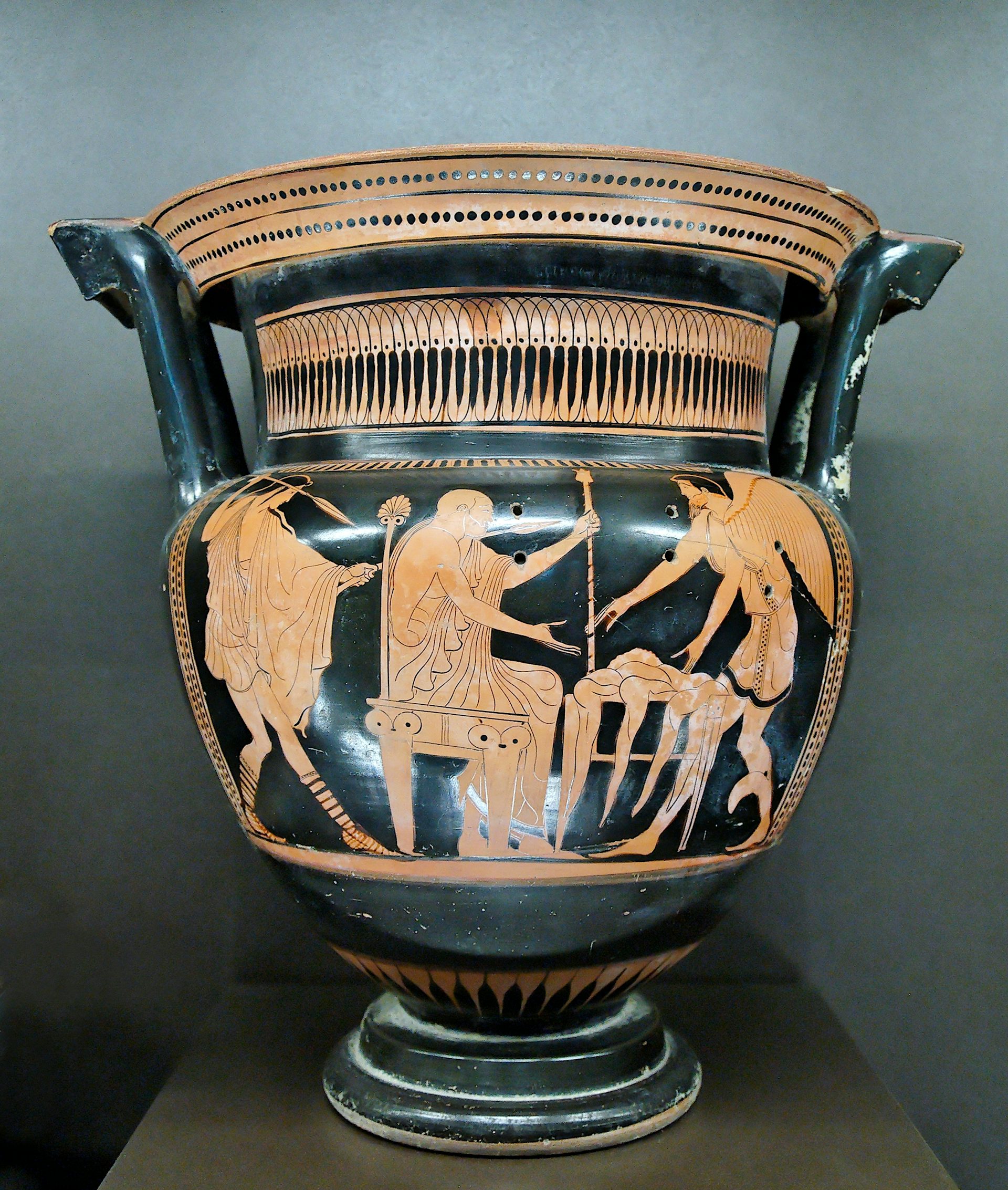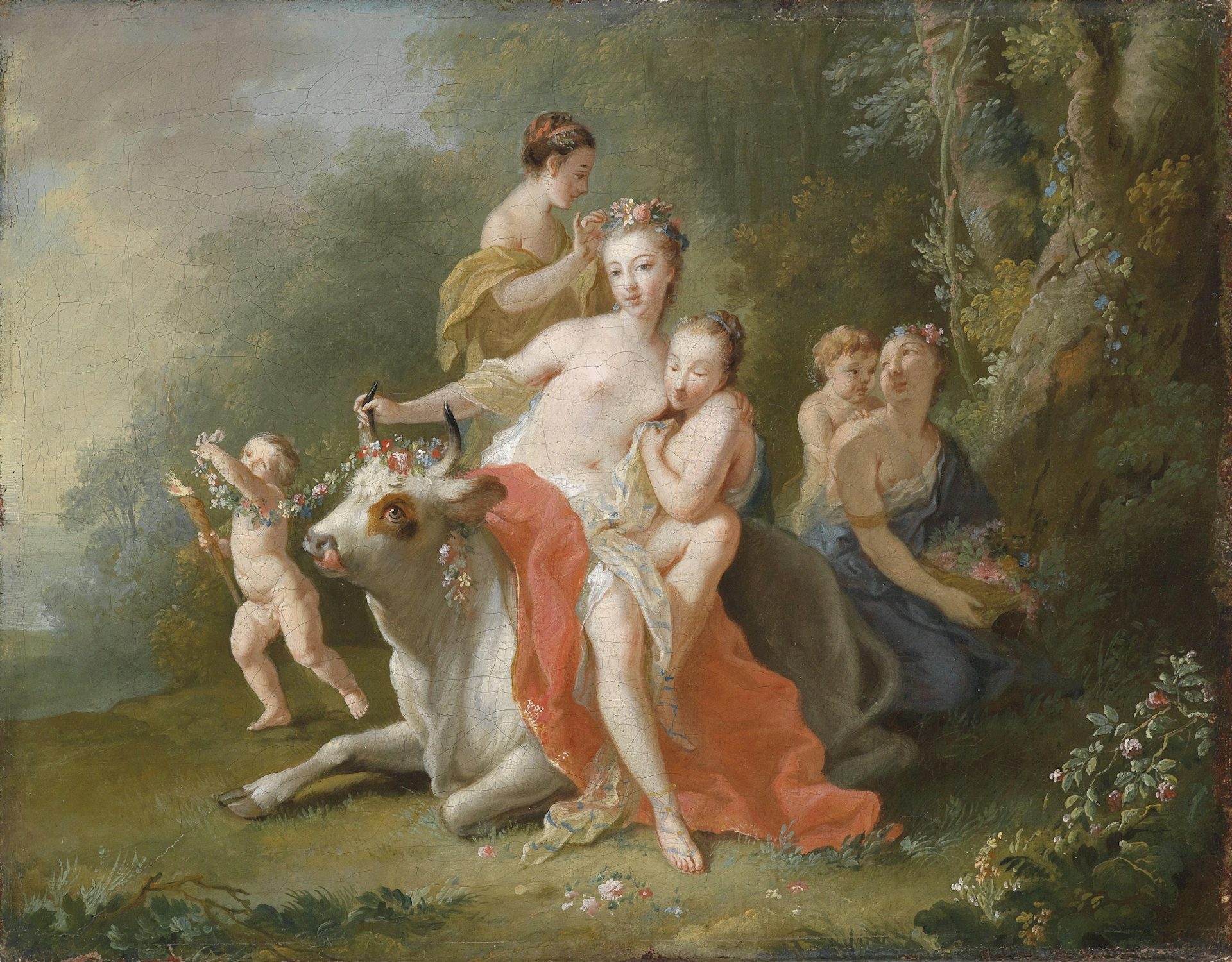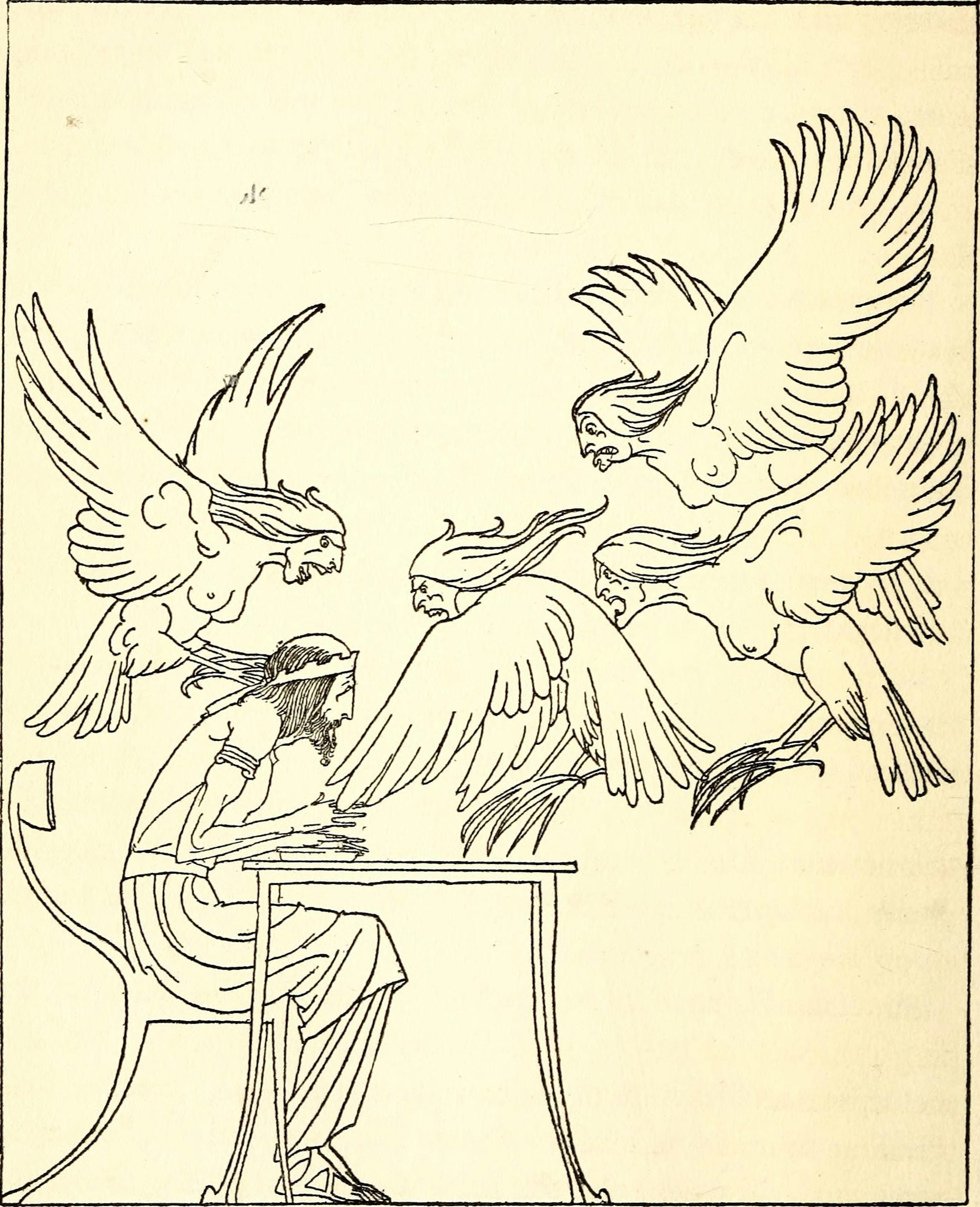Phineus

The Harpies Driven from the Table of King Phineus by Zetes and Calais by François Verdier (seventeenth or eighteenth century)
The Metropolitan Museum of ArtPublic DomainOverview
Phineus, son of Agenor (or, in some traditions, of the sea god Poseidon), was a prophet-king of Thrace; his kingdom was usually referred to as Salmydessus. Though Phineus was a powerful figure, he was blinded by the gods for committing some sin.
Ancient sources disagreed on the exact nature of this sin: some said that Phineus had prophesied the future too clearly, giving knowledge to mortals that was intended for the gods alone, while others claimed his blindness was a punishment for his savage mistreatment of his sons.
As if blindness weren’t enough, the gods also sent the Harpies to torment the aging king; these winged monsters would snatch away his food whenever he sat down for a meal.
Phineus is probably best known for his role in the myth of the Argonauts. The Argonauts, led by the hero Jason, stopped at Phineus’ kingdom on their way to seek the Golden Fleece. Seeing his sad condition, the heroes took pity on the king and saved him from the Harpies. In return, Phineus gave them valuable instructions and prophecies for their voyage.
Etymology
The etymology of the name “Phineus” (Greek Φινεύς, translit. Phineús) is uncertain. The mythical character of Phineus may have been invented as a namesake or “eponym” for the town of Phineion, located on the northern coast of Anatolia. The name may also be connected with φίναξ (phínax), a word of obscure and presumably foreign origin meaning “oak tree.”[1]
Pronunciation
English
Greek
Phineas Φινεύς (Phineús) Phonetic
IPA
[FIN-ee-uhs] /ˈfɪn i əs/
Attributes
General
Phineus ruled a land located somewhere in Thrace, a region of the Balkans north of Greece.[2] But the exact name and location of his kingdom varied across ancient sources.
In what became the standard account, Phineus was king of Salmydessus, a city on the western (European) side of the Bosporus.[3] Apollonius of Rhodes, on the other hand, claimed that Phineus ruled over Bithynia, on the eastern (Asian) side of the Bosporus.[4] In one surprising account, Phineus was called the king of Arcadia, a region in central Greece.[5]
Phineus’ chief attribute was his power of prophecy, a gift granted to him by Apollo (the god of prophecy).[6] But Phineus appears to have misused his ability—with fateful consequences.
Iconography
In ancient art, Phineus was generally depicted as an old man, with either white hair or a bald head. He often sported a long beard and was dressed simply, in an unadorned tunic or cloak. Some artists included a garland or scepter to highlight his kingly rank, or a laurel branch to highlight his prophetic office.

Attic red-figure column-krater showing Calais and Zetes rescuing Phineus from the Harpies by the Leningrad Painter (c. 460 BCE)
Louvre Museum, Paris / Marie-Lan NguyenPublic DomainPhineus was almost always represented in scenes from the Argonaut myth. His torment at the hands of the vicious Harpies was a particularly popular subject for ancient artists, as was Phineus’ rescue at the hands of Calais and Zetes—two Argonauts who had the power of flight.[7]
Family
Phineus was usually said to be the son of Agenor, an early king of Phoenicia.[8] This would have made him the brother of several famous figures, including Europa, Cadmus, and Phoenix. In another tradition, however, Phineus was the son of Poseidon,[9] while in yet another, he was the son not of Agenor but of Agenor’s son Phoenix, making his siblings Cilix, Doryclus, and Atymnus.[10]

The Rape of Europa by Johann Heinrich Tischbein the Elder (mid-18th century)
Wikimedia CommonsPublic DomainPhineus married multiple times. His first wife was Cleopatra, the daughter of Boreas and Orithyia.[11] He subsequently married Idaea, the daughter of Dardanus[12]—though in more obscure traditions, his second wife was said to be Cadmus’ sister Eidothea[13] or a woman named Eurytia.[14] There may have also been a tradition, now only hinted at in art, in which Phineus had a wife named Erichtho.[15]
Phineus had a number of children by both of his wives. His children with Cleopatra were called either Plexippus and Pandion,[16] Parthenius and Carambis,[17] Terymbas and Aspondus,[18] Polydectus and Polydorus,[19] Parthenius and Cromenus,[20] or Clytius and Polymedes.[21] Idaea, meanwhile, gave him two children: Thynus and Mariandynus.[22]
Other traditions also made Phineus the father of Paphlagon, the eponym of the region of Paphlagonia in Anatolia,[23] and the adoptive father of Thynus and Bithynus (or Mysus), also eponyms for regions in Anatolia.[24]
One much later source recounted a rationalized version of the Phineus myth in which Phineus had two daughters, Eraseia and Harpyreia, who were the true “Harpies,” squandering Phineus’ fortune.[25] Another source described a certain Olizone, wife of the Trojan king Dardanus, as the daughter of Phineus, but this was likely a different Phineus.[26]
Mythology
The Blindness of Phineus
Phineus was a prophet-king of Thrace. But while he could see clearly into the future, he could see nothing else due to his blindness. There are several radically different explanations for how and why Phineus lost his vision.
In one early account, Phineus traded his sight for a long life. He may have been given a choice: he could either become a prophet and lead a long life, but as a blind man, or he could lead a short but healthy life. Phineus apparently preferred the former.[27]
In another early account, Phineus was blinded because he gave Phrixus (or the sons of Phrixus) directions on a journey they were making. For reasons that are unclear, this helpfulness angered Aeetes, the king of Colchis and Phrixus’ father-in-law, who cursed Phineus. Phineus was promptly blinded by one of the gods (either Aeetes’ father Helios or Poseidon).[28]
Other authorities, including Apollonius of Rhodes, said that Phineus’ blindness was a punishment for telling prophecies that were too clear. In other words, he had revealed things to mortals that only the gods were supposed to know. Zeus thus blinded Phineus, sending the Harpies to torment him for good measure.[29]
In a more sinister tradition, Phineus was blinded due to his cruelty toward his oldest sons (see below). In one account, the gods were disgusted by Phineus’ behavior and resolved to punish him: they told him to choose between death and blindness. Phineus chose blindness, saying he preferred to never again look upon the sun god Helios than to die. This, however, offended Helios, who sent the Harpies to torment the now-blind Phineus.[30]
In a variant of this tradition, Phineus was blinded not by the gods but by the Boreads (Calais and Zetes), who were the brothers of Phineus’ first wife, and who were angry at how Phineus had treated their nephews.[31]
Whatever the reason for his punishment, Phineus suffered terribly. For a time, he was cared for by his close friend Paraebius.[32] In some happier accounts, Phineus was eventually saved from his troubles by the physician-hero Asclepius—or possibly even Jason—who used his skills to cure Phineus’ blindness.[33]
The Sons of Phineus
The most infamous myth about Phineus involved his treatment of his sons—specifically, the sons he had had with his first wife, Cleopatra. After Cleopatra died (or after Phineus divorced her), Phineus’ sons acquired a cruel, jealous stepmother—usually said to be Idaea, the daughter of Dardanus. Idaea saw Cleopatra’s sons as her rivals, so she told vicious lies about them to Phineus (in the usual account, she accused them of trying to rape her).[34]
Phineus apparently believed Idaea’s accusations. Thus, he (or Idaea) punished the boys very cruelly, either blinding them,[35] killing them,[36] or imprisoning them in a dungeon where they were given regular beatings.[37]
In some traditions, Phineus’ mistreatment of his sons was the reason he was punished with blindness. In others, these sons eventually managed to take their revenge, murdering their wicked stepmother as Cleopatra rejoiced.[38]
Phineus and the Argonauts
Despite his long, complicated, and confusing backstory, Phineus only had one notable role in Greek mythology. This occurred when Jason and the Argonauts stopped at his kingdom on their way to steal the Golden Fleece from Aeetes, the king of Colchis.
When the Argonauts arrived, Phineus received them warmly. He told them of his sufferings and promised to give them valuable instructions and prophecies related to their voyage if they saved him from the Harpies. The Harpies—swift winged monsters—would swoop down whenever Phineus tried to sit down for a meal, snatching away his food or defiling it so that it became inedible.
Among the heroes sailing with the Argonauts were Calais and Zetes, known as the Boreads (so named for their father Boreas, the north wind). The Boreads had wings and could fly; they therefore agreed to chase the Harpies away from Phineus once and for all. The two Argonauts prepared a meal to lure the terrible creatures, then waited nearby:
Scarcely had the aged man touched the food when they forthwith, like bitter blasts or flashes of lightning, suddenly darted from the clouds, and swooped down with a yell, fiercely craving for food; and the heroes beheld them and shouted in the midst of their onrush; but they at the cry devoured everything and sped away over the sea afar; and an intolerable stench remained.[39]
Upon spying the Harpies, the Boreads let out a cry and went after them; the Harpies flew away, and an airborne chase began. In one account, it seems the Harpies even tried to kidnap Phineus, snatching him in their talons and carrying him as far as the “land of the Glactophagi” in Thrace.[40]

Illustration of Phineus and the Harpies by Willy Pogany (1921)
Padraic Colum, The Golden Fleece and the Heroes who Lived before AchillesPublic DomainAt last the Boreads caught up with the Harpies. According to some accounts, they killed the creatures, but in the better-known tradition, one of the gods intervened. This god (usually said to be Hermes or Iris) commanded the Boreads to let the Harpies go but promised that they would never trouble Phineus again.[41]
The Boreads returned triumphant, and a grateful Phineus instructed the Argonauts on how to complete their voyage to Colchis (his most important advice concerned how to sail through the Symplegades, or “Clashing Rocks”). There may have also been a tradition, possibly represented in ancient art, in which Jason restored Phineus’ sight before the Argonauts left his shores.[42]
This was the common or standard tradition. But there was also another, grimmer version of what passed between Phineus and the Argonauts. According to some authorities, the Argonauts were horrified when they came to Phineus’ kingdom and discovered how Phineus had treated his sons.
The Boreads, who were the brothers of Phineus’ first wife Cleopatra, were especially angry. They rescued their nephews, and then (in one account) punished Phineus by blinding him and executing his lying wife Idaea.[43]
But in another account, Phineus refused to let the Boreads free his sons and ultimately led an army against them. Phineus and the Argonauts fought a terrible battle that only ended when Heracles (who had accompanied the Argonauts) killed Phineus. The Argonauts then placed the sons of Phineus and Cleopatra in Phineus’ vacant throne and continued on their way.[44]
Popular Culture
Phineus continues to appear in modern adaptations of the myth of the Argonauts. He has featured in novels such as Robert Graves’ Hercules, My Shipmate (1944) and films such as the popular Jason and the Argonauts (1963).